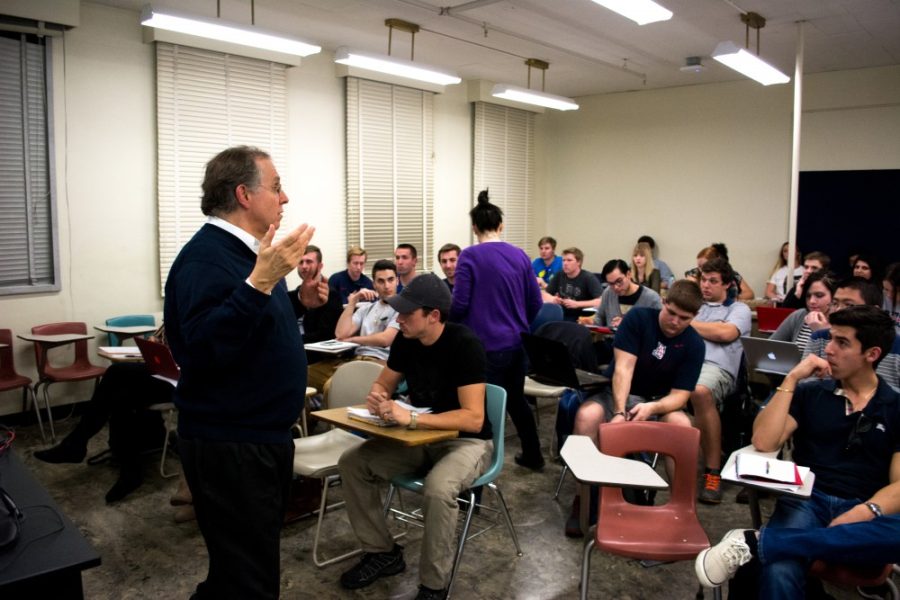The Arizona Board of Regents general education policy was revamped and rolled out in June 2019, beginning an initiative to reform general education requirements at all three Arizona universities.
The new policy gives special attention to a required American Institutions knowledge area. The ABOR policy outlines what the American Institutions requirement is and the expectations regarding history, economics, principles, government and program motivations.
“Integration of opportunities for students to practice civil discourse and civic engagement and to build their knowledge of the principles of American institutions is important given the complicated challenges we face in our own republic and in relationship to the rest of the world,” the policy read.
Unlike the designs produced at ASU and NAU in response to the new requirements, the University of Arizona’s general education does not incorporate an explicit American Institutions requirement. Rather, American Institutions are scattered across the curriculum in Exploring Perspectives and Building Connections requirements.
The shape of the UA’s general education, however, is not final, and organizers in the Office of General Education are working towards a meaningful American Institutions component. An important element of that is balancing logistical concerns with trying to create something palatable for students and faculty.
Susan Miller-Cochran (Ph.D.) is an English professor at the UA and serves as the executive director in the Office of General Education, a position and office newly created in response to the general education reform initiative.
“There are sometimes critiques that we’re not moving fast enough but there’s a give and take to that,” Miller-Cochran said. “ASU and NAU moved pretty fast […] ASU’s model was very much a top down model where a lot of things were decided by administration and enacted by administration.”
Slow, or measured?
Even before the recent revision of ABOR policy, plans had begun to be formulated at the UA to rework general education to focus on engaging students through more dynamic course offerings. This spirit was adapted to ABOR’s new requirements once established.
“Our curriculum was very much designed around this idea of autonomy and choice and making meaning out of your general education curriculum. The goal is to have this well integrated civic knowledge learning component,” Miller-Cochran said. “That choice is really important.”
The original revised ABOR policy, however, did not elaborate on what the only vaguely defined American Institutions meant. Clarification regarding expectations was only added later.
“They revised it and put in all of the detail about the content that needed to be in American Institutions February of 2021, which was two months before we were giving them our presentation on our whole program,” Miller-Cochran said. “We had only had a couple months to begin adjusting based on their interpretation of American Institutions.”
With the focus on student autonomy and engagement in mind, organizers in the Office of General Education wanted to avoid something akin to the UA’s present English foundations requirements, where every student has to take English 101 and 102 (or 109H).
Instead of everybody taking American National Government (POL 201), the idea is to have several options that mix different fields and focuses into a more varied selection of courses built around trying to promote engagement with the American Institutions material.
Miller-Cochran described four general frameworks that are currently being considered, but these frameworks are still subject to change. Each framework is different — the new model may feature a two course system, or a new Foundations course requirement — but in each case the goal is the same.
A dynamic process
Part of the new general education initiative is a greater overall organization, to facilitate satisfying requirements and also to ensure consistency and quality across courses and parts of the curriculum.
“Before we changed to the current general education system with the Exploring Perspectives and the Building Connections courses, in the former system, there wasn’t someone who was the executive director, there wasn’t an Office of General Education. […] There wasn’t a lot of coordination across general education,” Miller-Cochran said.
In spite of the new centralization, the development process is a dynamic one. Organizers have made a point to incorporate perspectives from across campus into an open, ongoing discourse, and to combine faculty experience with the new central planning.
Ryan Winet, director of communications in the Office of General Education, compared the ongoing design process to the design of a mall.
“As the developer of this curricular mall, we don’t create the stores or the shops that operate in there. What we do is we create the mall and say, ‘the university-wide general education curriculum will review these courses and once those are approved, it’s up to the department but really also the college,’ where you have a lot more faculty expertise and experience in teaching these courses,” Winet said.
Miller-Cochran, Winet and the others in the Office of General Education work with faculty and other entities on campus — including through an advisory board and the university-wide General Education Committee — to coordinate and to craft policy and approve courses.
Proposing and teaching courses is still left to faculty, critical for achieving the goal of connecting American Institutions to students’ interests and studies through different courses bringing together different disciplines, and run by different departments.
“I think it’s very important for experts to talk about what they imagine this should look like,” Winet said.
No easy solution
On the one hand, the process is complicated by this concern for student experience. Student engagement calls for a more dynamic process, and requirements have to be added without overburdening students, something Miller-Cochran was concerned with.
“One of the things I said was a deal breaker for me was I don’t want to add any more credits to gen-ed,” Miller Cochran said.
At a recent meeting of the advisory board on Oct. 9, Allison Ewing-Cooper, director of academic advising for the College of Social and Behavioral Sciences, noted that any program that was too complex would be unfriendly to prospective transfer students. It would be difficult to determine what can count for transfer credit.
Spencer Lindsay is a professor in the School of Government and Public Policy and one of several others who have been involved in the design process at some level. Lindsay is one of the faculty at the SGPP who will likely have to teach some of the new courses related to American Institutions. Lindsay had similar thoughts to others regarding the student experience.
“What’s interesting is the idea that you have a breadth department where you go and you take Intro to American Government or the set of probably 10 courses across the university, and then you have the depth where you can take something relevant to your major that still focuses on civic engagement and the governmental system and how your field interacts with it,” Lindsay said. “We want everyone to have a basic level of knowledge of certain topics like civics, but we also don’t want to force things down people’s throats and have people kind of resent it.”
But there are also significant logistical roadblocks to implementation on the department and faculty side. One of the major questions concerns how best to distribute the burden of a new American Institutions requirement. There are simply too few faculty in too few departments.
“[Certain models] would fulfill the needs of the university. But I have concerns that it would put a lot of stress on certain departments. The faculty has expressed a lot of concern about that,” Lindsay said. “[…] We also want to share the wealth and have other departments get involved, and have other departments thinking about some of these issues that are really important, like civic engagement and all that stuff.”
The timeline
As this process grinds on, the UA remains in an interim period without an identifiable focus on American Institutions requirements. Miller-Cochran, Winet and Lindsay, however, all were skeptical about the prospect of putting in place a stopgap measure, or an incomplete program as a soft launch — like requiring every student to take POL 201.
Miller-Cochran didn’t want to force on students a program that was not very effective or well thought out. Lindsay was unsure if such a measure would be possible.
“I think there are issues with the institutional structure where it’s understood [at some other institutions] that the vast majority of people who get hired will be teaching Intro to American Government,” Lindsay said. “Even if you’re an International Relations scholar, even if you’re a comparative scholar, you just have to do it, and that’s not the model the U of A has. And that could cause a lot of problems because that’s just not what the system was designed for.”
Although there are several dozen faculty in just the SGPP alone, there are only a handful whose specialties are in American politics and who, as it stands, would be poised to teach something like POL 201: American National Government.
As for the standing timeline, Miller-Cochran suggested that a framework for an American Institutions component could be decided on shortly.
“We have to implement the attributes as graduation requirements in Fall of 2026 […] so whatever we are doing with civic learning, it needs to be in place as policy in time for it to be rolled out as part of the graduation requirements in 2026. So there is a timeline for that [ …] and that actually doesn’t put us very far behind where ASU and NAU are at all,” Miller-Cochran said.
Follow the Daily Wildcat on Instagram and Twitter/X









